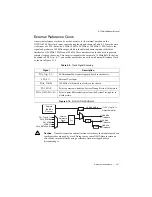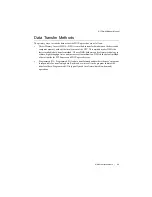
2-1
8
|
ni.com
Chapter 2
Using the NI PXIe-4300
10 MHz Reference Clock
The 10 MHz reference clock can be used to synchronize other devices to the NI PXIe-4300
module. The 10 MHz reference clock can be routed to the PXI_Trig <0..7> terminals. Other
devices connected to the PXI_Trig bus can use this signal as a clock input.
The 10 MHz reference clock is generated by dividing down the onboard oscillator.
Synchronizing Multiple Devices
On PXI Express systems, you can synchronize devices to PXIe_CLK100. In this application the
PXI Express chassis acts as the initiator. Each PXI Express module uses PXIe_CLK100 as its
reference clock. Adding channels from multiple modules to the same NI-DAQmx task will
perform synchronization automatically.
Another option in PXI Express systems is to use PXI_STAR. The Star Trigger controller device
acts as the initiator and drives PXI_STAR with a clock signal. Each target module uses
PXI_STAR as its external reference clock.
With the PXI_Trig bus and the routing capabilities of the NI PXIe-4300 module, there are
several ways to synchronize multiple modules depending on your application.
To synchronize multiple modules to a common timebase, choose one module—the master—to
generate the timebase. The master module routes its 10 MHz reference clock to one of the
PXI_Trig <0..7> signals.
All modules (including the master module) receive the 10 MHz reference clock from PXI_Trig.
This signal becomes the external reference clock. A PLL on each module generates the internal
timebases synchronous to the external reference clock.
Sharing a trigger between multiple devices using PXI trigger lines introduces skew in the trigger
signal, due to the propagation delay of the signal. The NI PXIe-4300 can compensate for that
skew by locking the trigger to a clock (PXIe_SYNC100) that is derived from the reference clock
(PXIe_CLK100). When you lock triggers to a clock, the device responds to those triggers on a
subsequent edge of that clock, rather than immediately. Therefore, skew correction results in
increased latency.
When you add multiple NI PXIe-4300 modules to the same NI-DAQmx task, NI-DAQmx
automatically enables trigger skew correction. To enable trigger skew correction for applications
that use multiple NI-DAQmx tasks, specify which device is the master and which devices are
the slaves using the
SyncType
DAQmx Trigger property.











































